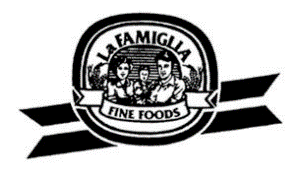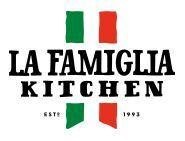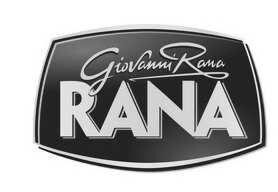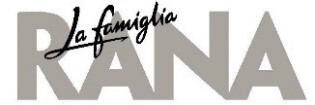Federal Court issues decision in LA FAMIGLIA case
30 July 2021
An earlier version of this article first appeared on WTR Daily, part of World Trademark Review, in May 2021. For further information, please go to www.worldtrademarkreview.com.
On 17 December 2020 the Federal Court of Australia issued its decision in Goodman Fielder Pte Ltd v Conga Foods Pty Ltd ([2020] FCA 1808).
The case dealt with the use of LA FAMIGLIA RANA in connection with filled pasta products in the face of existing trade mark registrations for LA FAMIGLIA (and other variations) for bread products. The court considered whether the use of LA FAMIGLIA RANA infringed the registrations after assessing whether those trade marks were vulnerable to removal from the register for non-use, no intention to use and lack of distinctiveness.
- At issue was whether the respondents could use LA FAMIGLIA RANA for filled pasta products in the face of existing registrations for LA FAMIGLIA for bread products.
- The court found that the respondents infringed the applicants’ registrations.
- The decision shows that it is possible to protect an indirectly descriptive sign.
Background
In 1993 La Famiglia Fine Foods Pty Ltd began producing and selling different breads and, in December 2005, was acquired by Goodman Fielder Group (together, the applicants).
In November 2017 Conga Foods Pty Ltd began importing pasta products into Australia from Pastificio Rana SpA (together, the respondents). The parties’ trade marks are set out below.
The applicants’ registered trade marks:
Mark | TM No. | Class | Priority date |
| 701727 (Applicants conceded to removal of this mark) | Class 30 | 5 February 1996 |
LA FAMIGLIA TAKE AND BAKE and LA FAMIGLIA TAKE ‘N’ BAKE | 1130187 (Applicants conceded to removal of this mark) | Class 30 | 16 August 2006 |
LA FAMIGLIA (473 word mark) | 1155473 | Class 30 | 8 January 2007 |
(906 composite mark) | 1171906 | Class 30 | 19 April 2007 |
LA FAMIGLIA KITCHEN (133 word mark) | 1689133 | Class 30 | 23 April 2015 |
(131 composite mark) | 1689131 | Class 30 | 23 April 2015 |
The respondents’ trade marks:
Mark | TM No. | Class | Priority date |
(Giovanni Rana mark) | 1827822 | Class 29, 30 and 43 | 23 February 2017 |
(Rana mark) | 1875074 (pending application, which was deferred pending resolution of the proceeding) | Class 30 | 22 September 2017 |
The pasta products imported by Conga into Australia bore the RANA mark, an example of which is shown below:
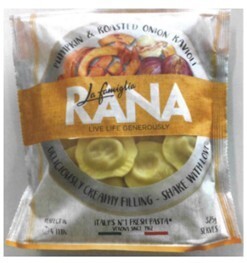
Court proceedings were commenced for infringement of two of the registrations by use of the RANA mark in connection with pasta goods. There was a cross-claim made for cancellation of the applicants’ trade marks on the basis that they were vulnerable to removal from the register for non-use or lack of intention to use pursuant to sections 59 and 92(4) of the Trade Marks Act 1995(Cth) (the Act), and that they lacked distinctiveness under section 44 of the Act.
The applicants conceded that two of its initial six trade marks in suit should be removed from the register and chose to limit the range of goods specified in Class 30 for the remaining registrations. The limited specifications of goods are shown below:
Trade mark | Designated goods |
473 word mark | Bread, bread rolls, buns, flat bread, pizza bases, pizza dough, ciabatta and focaccia bread and rolls; garlic bread; herb bread; cheese bread; bread sticks; frozen, chilled and shelf stable bread; foodstuffs having a base of rice, of flour or of cereals, also in the form of ready made dishes.* |
906 composite mark | Pizza bases, pizza dough, ciabatta and focaccia bread and rolls; garlic bread; herb bread; cheese bread; bread sticks; frozen, chilled and shelf stable bread; foodstuffs having a base of rice, of flour or of cereals, also in the form of ready made dishes.* |
133 word mark 131 composite mark | Pizza bases, pizza dough, ciabatta and focaccia bread and rolls; garlic bread; herb bread; cheese bread; bread sticks; sandwiches; frozen, chilled and shelf stable bread; foodstuffs having a base of rice, of flour or of cereals, also in the form of readymade dishes. |
*In considering the court’s discretion to keep trade marks on the Register, the applicants submitted that the underlined portion of the designated goods for the 473 word mark and the 906 composite mark should be replaced with a more limited selection of goods, being ‘Italian-style ready-made dishes being rice and pasta-based meals such as risotto, lasagne and spaghetti Bolognese’.
In considering the rectification claim, Justice Burley of the Federal Court also addressed his discretion under sections 88 and 101 of the Act not to remove the trade marks’ designated goods, except for ‘foodstuffs having a base of rice, of flour or of cereals, also in the form of ready-made dishes’ (the 'general foodstuffs category'), which the applicants argued should be replaced by the more limited words ‘Italian-style ready made dishes being rice and pasta-based meals such as risotto, lasagne and spaghetti bolognese’ (the 'ready-made meal category').
Issues
Justice Burley considered a range of issues but, given the complexity and length of the decision, this update only deals with the most interesting points below.
Rectification – lack of use or intention to use
The respondents argued that the applicants’ trade mark registrations should be limited to ‘bread and bread products’ on the basis that there was no actual use during the relevant time period and no intention to use as at the filing date.
Actual use
The evidence of use included website captures, sales data, marketing materials such as retailer catalogues, social media screenshots and the registered domain name ‘lafamiglia.com.au’ for the 473 word mark.
It was found that the applicants’ trade marks had each been used during the relevant periods of time in respect of ’bread and bread products’ and that such use encompassed all of the designated goods for those trade marks, except for pizza bases, pizza dough and the general food stuffs category.
Justice Burley considered use of the 131 composite mark to be use of the 133 word mark, as the composite mark did not substantially affect the identity of the word mark.
Intention to use
For intention to use, Justice Burley only assessed the designated goods for which he had not already found actual use, being pizza bases, pizza dough and the general foodstuffs category.
Pizza bases and pizza dough were found to be sufficiently similar to bread products, for which he had already found use. The similarity between the goods, combined with evidence of different brand planning documents/presentations and data of actual sales of pizza base products, was enough for a finding of intention to use.
No intention to use was found for the general foodstuffs category. The key reasons for this finding included:
- Broad and preliminary brand plans – the documentary evidence provided did not demonstrate any real and definite intention to expand the range of goods (at paragraphs 149 and 169) and no one from the applicants provided any explanation of the intention to use at the date of filing (at paragraphs 150 and 194]).
- Ability to produce an expanded range of goods – there was no evidence that the applicants were able to produce goods beyond bread products (at paragraphs 154 and 197).
- Had not progressed any new products - since the filing date the applicants had not even come close to launching products other than bread and bread products (at paragraphs 152 and 195).
Justice Burley concluded that the register should be rectified to only include the designated goods and struck out the general foodstuffs category.
Lack of distinctiveness
Justice Burley considered the distinctiveness of each of the applicants’ trade marks. For the 906 composite mark, Justice Burley easily found that this mark was distinctive because it was a composite mark (paragraph 245).
The 473 word mark was not considered directly descriptive thanks to the addition of the definite article ‘la’ in front of ‘famiglia’, which took the mark away from being interpreted as ‘family made’ or ‘family sized’. Instead, Justice Burley felt that the meaning of ‘the family’ (‘la famiglia’) ‘connote[s] whatever association an individual may have to an Italian… version of the words ‘the family’… likely to import a reference to positive attributes relating to Mediterranean or Italian dining and cooking, such as eating in a larger group’ (at paragraph 234).
It is interesting to note that Justice Burley found that the mere addition of ‘la’ made the mark more distinctive.
The most descriptive mark was the 133 word mark (and 131 composite mark), which Justice Burley said was 'less allusive and more literal in its meaning' (at Paragraph 249) and indicated that the source of the good is a family kitchen. He felt that the addition of the word ‘kitchen’ made it more descriptive than ‘la famiglia’ used on its own. Although it was considered almost descriptive, Justice Burley concluded that LA FAMIGLIA KITCHEN is sufficiently inherently adapted to distinguish the goods to which it is applied, given the reference to the potential origin of the goods is indirect and the combination of English and Italian. He came to the same conclusion for the 131 composite mark.
Exercise of discretion
Insofar as the 473 word mark and the 906 composite mark were concerned, although there was no evidence of any actual use in respect of the general foodstuffs category, the court retains a discretion not to cancel registrations (or to limit goods) even where there has been no use established under sections 88 and 101 of the Act. The applicants sought the exercise of that discretion for the ready-made meal category, requesting that it replace the general foodstuffs category on the basis that it is a narrower set of goods.
Justice Burley considered whether the ready-made meal category is ‘goods of the same description’ as the goods for which he had already found use, being garlic bread. The consideration of whether these goods are goods of the same description is relevant to the discretion of the court to keep certain goods on the register even where there is no evidence of actual use of the trade mark for those exact goods. He considered:
- the nature of the goods, including their origin and characteristics;
- the uses made of them, including purpose; and
- the trade channels through which the goods are bought and sold.
After weighing the different considerations, garlic bread and ready-made meals were found to be goods of the same description. The factors weighed included that:
- garlic bread is likely to be understood as a natural accompaniment to Italian meals (such as ready-made meals);
- garlic bread and ready-made meals are likely to be displayed together in the refrigerated section of the supermarket; and
- ultimately, there was a likelihood consumers would be confused by the different goods bearing the same trade mark.
Despite this, Justice Burley noted the underlying policy and purpose of the Act, that if a trade mark is unused, or not intended to be used at the date of filing, it should not be registered (at paragraph 289). With this in mind, Justice Burley found that the ‘indefensible’ range of goods covered by the trade mark registrations (which originally included chocolate, yoghurt and foodstuffs made of grain) ‘was not justified by either dint of use or intention’ (at paragraph 290). Accordingly, Justice Burley chose not to exercise his discretion in respect of the ready-made meal category.
The applicants sought the Court’s discretion to keep the general foodstuffs category for the 133 word mark and the 131 composite mark, but ultimately this category was too broad.
Justice Burley also exercised his discretion to retain pizza bases and pizza dough, for all of the applicants’ trade marks.
Infringement
The applicants alleged infringement of the 473 and 133 word marks for use of the RANA mark, which included ‘La Famiglia’ in cursive writing. The words ‘La Famiglia’ also appeared on the respondents’ Facebook and Instagram handles.
The RANA mark was found to be deceptively similar to the 473 word mark, because it so nearly resembles the 473 word mark that it is likely to deceive or cause confusion. Justice Burley disagreed with the respondents that the inclusion of the large font word ‘RANA’ in the RANA mark would provide sufficient differentiation to consumers, such that they would not wonder whether the competing products came from the same source (at paragraph 344). Additionally, the speed at which consumers select the applicants’ goods and the way in which the goods are likely to be displayed in supermarkets meant that consumers would be more likely to be deceived or confused by use of the RANA mark on filled pasta products. This decision demonstrated that it is insufficient to avoid infringement to simply add additional material when the infringer has otherwise adopted the entire registration.
Justice Burley considered that filled pasta products and bread products were goods of the same description because ready-made meals are similar to filled pasta – they can both be made quickly and easily – and that ‘by virtue of being of the same character as a “ready-made meal”, filled pasta is also a good of the same description as garlic bread’ (at paragraph 359). He thus found that the RANA mark and its use on pasta products infringed the 473 and 133 word marks.
The respondents attempted to rely on the provisions of section 120(2) of the Act, which provides that, where the infringing sign is used for related goods or services for which the mark is registered (not the same goods or services) and the sign’s specific use would not be likely to deceive or cause confusion, then there is no infringement. Justice Burley noted that the respondents should have expressly pleaded that defence. The respondents needed to show that the way in which they used the RANA mark was not likely to deceive or cause confusion, and for the defence to be considered it was insufficient to generally deny the allegation of infringement under section 120(2). In any event, Justice Burley found that the respondents would have failed to make out this defence for substantially the same reasons as his findings on deceptive similarity and goods of the same description.
Findings
The respondents were only successful in part under non-use and no intention to use, resulting in exclusion from the register of only the general foodstuffs category (as well as the goods voluntarily disclaimed by the applicants). Justice Burley found that the respondents had infringed the applicants’ registrations.
The matter is not yet concluded as it has been appealed and is due to be heard in late August 2021.
Comment
This case has provided some interesting points to consider in respect of trade marks and litigation, including:
- Careful consideration of goods and services – selection of the goods or services for which registration is sought needs to be carefully considered from the outset of a project. Using a broad-brush approach may not necessarily provide any benefit to the owner of the trade mark down the line.
- Distinctiveness of a trade mark – when selecting a brand and registering a trade mark, it is possible to protect an indirectly descriptive sign.
- Express pleadings – the defence available under section 120(2) of the Act should be expressly pled and evidence should be led on that point to the extent that it differs from the other considerations relating to infringement.
- It is not easy to rely, for the purposes of proving 'use', on general plans for launching a trade mark in respect of a new range of goods, especially where there was no capacity to actually produce the type of goods in question.
Authors

Partner
Senior Associate
Tags
This publication is introductory in nature. Its content is current at the date of publication. It does not constitute legal advice and should not be relied upon as such. You should always obtain legal advice based on your specific circumstances before taking any action relating to matters covered by this publication. Some information may have been obtained from external sources, and we cannot guarantee the accuracy or currency of any such information.

